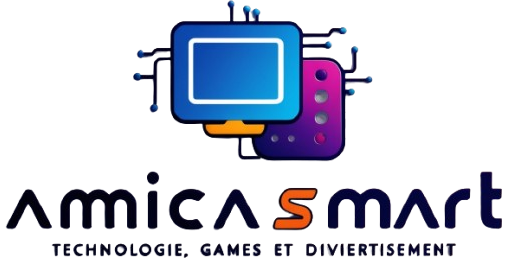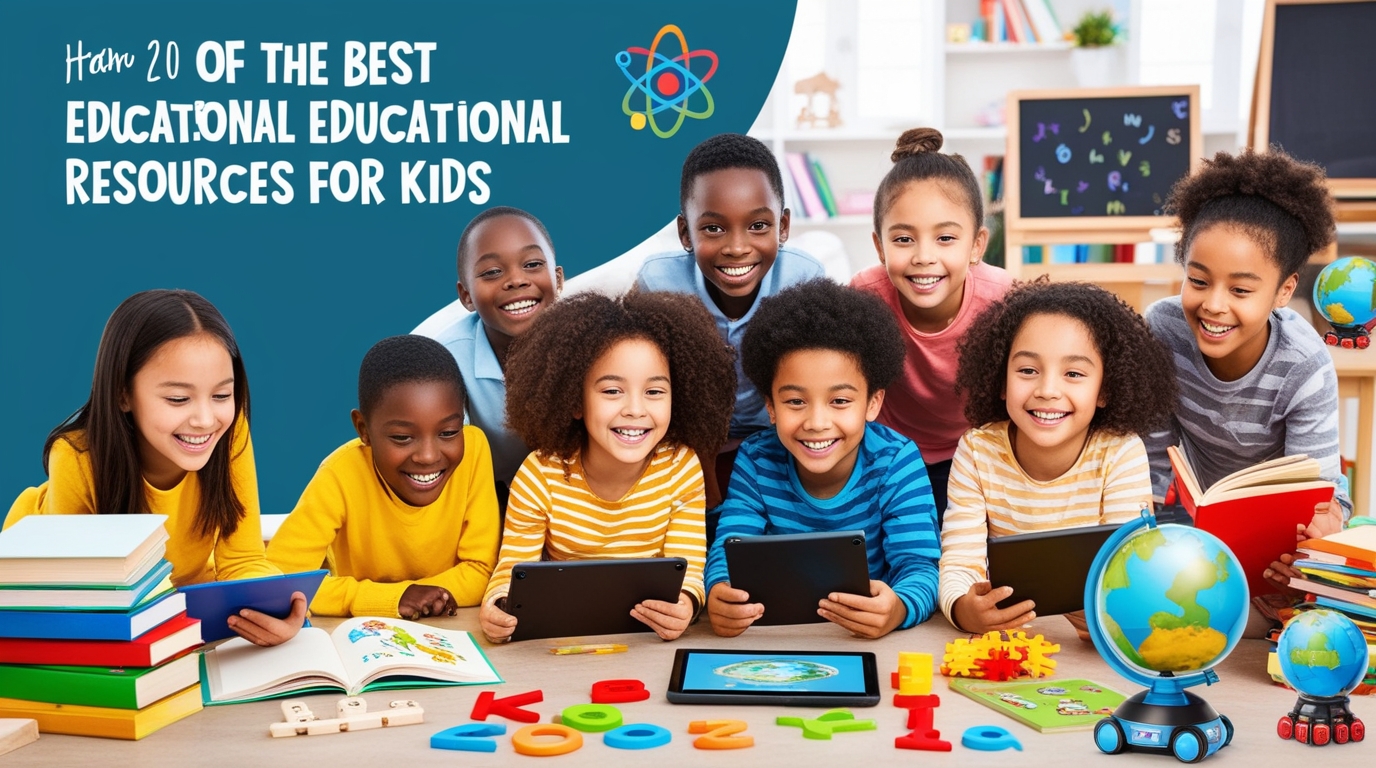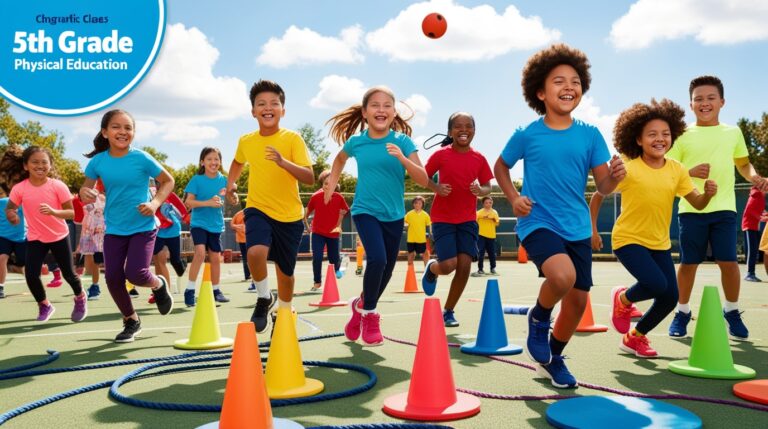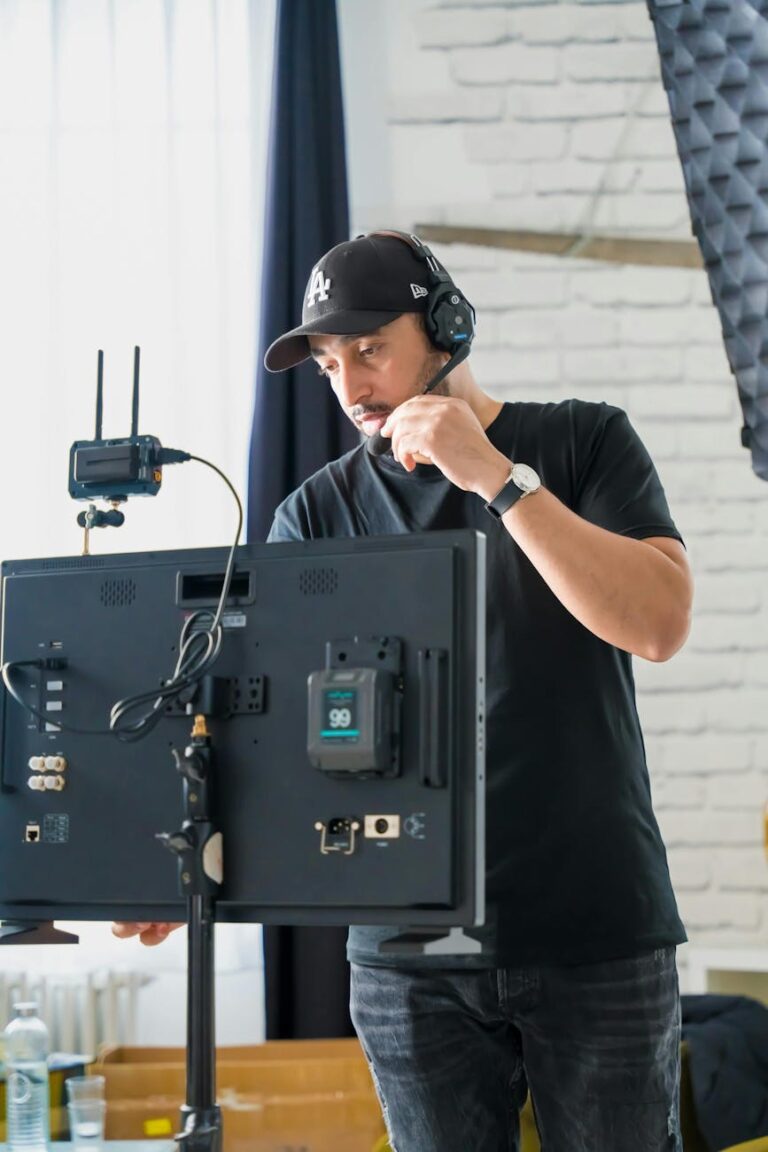Best Educational Resources for Kids: Fun Ways to Learn and Grow
1. Introduction
Best Educational Resources for Kids Every parent wants the best for their child—especially when it comes to education. In today’s world, learning isn’t limited to textbooks and classrooms. Kids have access to an ocean of knowledge through interactive games, educational websites, and creative apps that make learning both enjoyable and effective. The key is to make education feel like an adventure, not a chore.
Educational content plays a crucial role in shaping a child’s intellectual and emotional growth. It helps them develop problem-solving skills, communication abilities, and a lifelong love for learning. When kids enjoy what they learn, they retain more information and apply it better in real-life situations. That’s why choosing the best educational resources for kids has become a top priority for modern parents and teachers.
Today, we’ll explore the most effective, engaging, and fun educational tools and strategies that not only teach kids but also nurture their creativity, confidence, and curiosity.
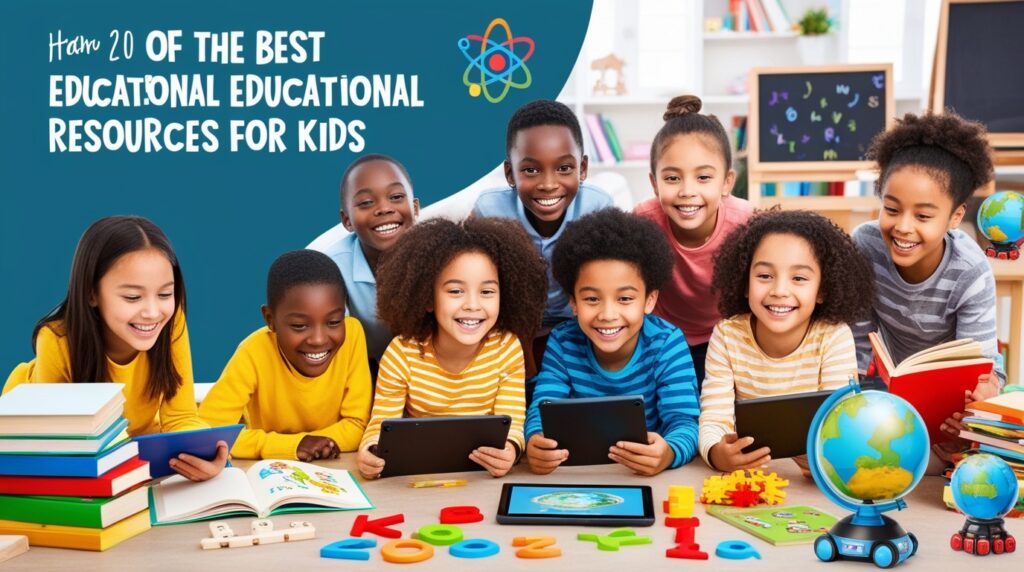
2. The Evolution of Learning for Kids
Gone are the days when education meant sitting in a classroom, listening to lectures, and memorizing facts from textbooks. The learning landscape has changed dramatically over the last two decades. Now, education is interactive, visual, and accessible anytime, anywhere.
The digital age has brought revolutionary platforms that combine entertainment with education—something often referred to as “edutainment.” From animated learning videos to virtual science labs and coding games, kids can now explore subjects in immersive ways that textbooks never could.
Moreover, technology has democratized education. Children from all backgrounds can access quality learning materials online—something that was unthinkable a few decades ago. The COVID-19 pandemic further accelerated this digital transformation, pushing parents, educators, and students to embrace online tools.
Yet, while technology offers endless opportunities, it’s crucial to strike a balance. Combining traditional learning with modern tools ensures that children benefit from both structure and creativity.
3. Benefits of Educational Resources for Kids
Why invest time and energy in finding the best educational content for your child? Because the right resources can shape not just what your child learns—but how they think and grow.
Here are some key benefits:
- Cognitive Development: Interactive learning materials engage a child’s brain more deeply than passive learning. Games, puzzles, and videos encourage reasoning, logic, and analytical thinking.
- Emotional Growth: Many educational tools teach empathy, teamwork, and patience—skills that are crucial for emotional intelligence.
- Boosts Creativity: Activities like drawing, music, and storytelling unleash imagination while developing fine motor skills.
- Encourages Independence: When kids explore educational platforms on their own, they learn self-motivation and problem-solving.
- Improves Academic Performance: Studies show that kids using digital educational platforms often perform better in school because they understand concepts visually and practically.
In short, educational resources are more than just learning aids—they’re tools that build confident, curious, and capable children.
4. Top Online Educational Platforms for Kids
The internet is filled with thousands of websites and apps for children, but not all are created equal. The best educational platforms are those that balance fun with effective learning. Here are some of the most trusted and widely used options:
a. ABCmouse
Perfect for kids aged 2–8, ABCmouse offers a full curriculum covering reading, math, science, and art. Its engaging lessons and progress-tracking system make it ideal for early learners.
b. Khan Academy Kids
Completely free and designed by education experts, Khan Academy Kids focuses on foundational skills—math, reading, and logical reasoning—through cute animal characters and story-based lessons.
c. National Geographic Kids
This site combines adventure with knowledge. It helps children explore the world through stunning photos, fun facts, and quizzes that make science and geography exciting.
d. PBS Kids
Known for its educational TV shows, PBS Kids offers interactive games and videos featuring beloved characters. It’s one of the safest and most engaging learning hubs online.
e. BrainPOP
BrainPOP is a favorite among schools and parents. It covers topics ranging from history and technology to health and arts—all delivered through short, animated videos.
When choosing a platform, consider your child’s age, interests, and learning style. Look for sites that encourage exploration rather than rote learning, and always monitor screen time.
5. Best Educational Games for Kids
Who says learning can’t be fun? Educational games prove that kids can absorb new knowledge while having a blast. These games combine strategy, creativity, and critical thinking—turning learning into a playful adventure.
Here are some standout examples:
- Prodigy Math Game: This RPG-style math adventure lets kids solve math problems to progress in the game world. It’s fun, competitive, and perfect for ages 6–12.
- Minecraft: Education Edition: Beyond building structures, this version of Minecraft teaches coding, physics, teamwork, and creativity.
- Osmo Learning System: By combining physical play with digital apps, Osmo helps children learn math, drawing, and spelling in a hands-on way.
- Kahoot!: A quiz-based platform that makes learning social and interactive—great for classrooms or home study groups.
- Toca Boca: Offers imaginative games for young kids that foster creativity, storytelling, and exploration.
Games like these encourage persistence, logical reasoning, and collaboration—all while keeping kids entertained. However, moderation is key. Parents should ensure that game time complements, not replaces, traditional study time.
6. STEM Learning for Kids
STEM—Science, Technology, Engineering, and Mathematics—is no longer just for high schoolers or college students. Today, even preschoolers are being introduced to these core subjects through fun, engaging, and age-appropriate tools. STEM learning helps children develop logical reasoning, problem-solving skills, and curiosity about how the world works.
When kids engage with STEM resources early, they build a solid foundation for future careers in technology, medicine, architecture, and more. But most importantly, they learn to think critically and creatively—skills essential in every aspect of life.
Best STEM Resources for Kids:
- LittleBits: A hands-on electronic building kit that allows kids to create circuits and simple machines.
- LEGO Education: Combines the joy of building with real-world problem-solving activities.
- Scratch: A free platform from MIT that teaches coding through storytelling and animation.
- Kodable: Ideal for younger children, introducing them to programming logic in a fun, game-like environment.
STEM education isn’t just about numbers or science facts—it’s about nurturing curiosity and innovation. Parents can encourage their kids by turning everyday moments into mini science experiments or math challenges, sparking a love for discovery that lasts a lifetime.
7. Creative Arts and Language Learning
While STEM sharpens logic and analysis, creative arts and language learning strengthen imagination, empathy, and communication. Music, art, dance, and storytelling teach children how to express their emotions and understand others.
Art also builds fine motor skills and improves focus. Drawing, painting, and crafting can help children calm their minds and boost self-esteem. Music, on the other hand, helps with pattern recognition and memory, both of which are vital for academic success.
Top Creative Learning Tools:
- Crayola Create & Play: Encourages kids to explore colors, shapes, and creativity.
- Duolingo Kids: A gamified language-learning app that introduces new words and phrases in a playful way.
- Simply Piano: Helps kids learn piano at their own pace through step-by-step video guidance.
- Storybird: A creative platform where children write and illustrate their own stories.
Learning another language also improves problem-solving and multitasking skills. Children who learn multiple languages early on often show enhanced cognitive flexibility and cultural awareness.
Creative arts and languages go hand in hand with emotional and social intelligence—preparing kids to connect, collaborate, and communicate with confidence.
8. Educational YouTube Channels for Kids
YouTube has evolved into one of the most powerful educational tools for children—if used wisely. The right channels can turn screen time into learning time, offering fun lessons through visuals, songs, and experiments.
Top YouTube Channels for Kids:
- National Geographic Kids: Fascinating videos about wildlife, science, and the planet.
- CrashCourse Kids: Simplifies complex scientific topics with humor and animation.
- PBS Kids: Trusted educational content featuring characters like Daniel Tiger and Elinor Wonders Why.
- Cosmic Kids Yoga: Combines storytelling with yoga for physical and mental balance.
- Khan Academy Kids: Engaging lessons covering math, reading, and emotional learning.
YouTube makes complex topics simple and relatable. For instance, a five-minute animated video can explain how volcanoes erupt or why the sky is blue in ways a textbook never could.
However, screen time management is crucial. Parents should use YouTube Kids, a safer platform with age-appropriate filters. Setting viewing limits and co-watching with children enhances understanding and prevents overexposure to screens.
In moderation, educational videos can be powerful tools to spark curiosity, inspire creativity, and reinforce classroom learning.
9. Printable and Offline Educational Activities
In the digital era, it’s easy to forget the power of offline learning. Printable worksheets, DIY projects, and hands-on activities remain some of the best ways to help kids learn by doing. These activities develop fine motor skills, concentration, and problem-solving abilities without the distractions of a screen.
Fun Printable & Offline Ideas:
- DIY Flashcards: Perfect for learning alphabets, shapes, and basic math.
- Science Experiments at Home: Simple experiments like making a volcano or growing crystals spark scientific thinking.
- Educational Board Games: Games like Scrabble Junior, Monopoly Junior, and Math Bingo make learning interactive.
- Outdoor Learning: Nature walks, gardening, and scavenger hunts teach observation, patience, and environmental awareness.
Offline learning also strengthens the parent-child bond. When parents participate in games, crafts, or reading sessions, children feel more confident and supported. Plus, unplugged activities teach patience and focus—two traits that can fade in a screen-dominated world.
Balance is key. Mixing digital and offline learning ensures that kids develop well-rounded skills while staying mentally and emotionally healthy.
10. Role of Parents and Teachers in Kids’ Education
No educational tool—no matter how advanced—can replace the guidance and encouragement of parents and teachers. They are the pillars of a child’s learning journey. Parents set the tone at home, while teachers shape learning habits and curiosity in school.
For parents, the goal isn’t just to monitor, but to participate. Asking questions like “What did you learn today?” or “Can you show me how this game works?” turns learning into a two-way interaction. It helps children feel valued and motivated.
Teachers, on the other hand, play a crucial role in integrating digital and traditional education. They identify each child’s strengths, adapt lessons accordingly, and create a supportive learning environment.
Tips for Parents and Teachers:
- Create a Learning Routine: Consistency builds discipline and helps kids focus.
- Encourage Curiosity: Let kids ask “why” and “how” questions—it fosters critical thinking.
- Use Positive Reinforcement: Praise effort, not just results. It motivates children to keep improving.
- Set Screen Time Limits: Teach balance between online learning and real-world experiences.
- Stay Involved: Attend school meetings, monitor progress, and celebrate small wins.
Ultimately, education is a team effort. When parents and teachers collaborate, they create a nurturing ecosystem where kids thrive academically, socially, and emotionally.
6. STEM Learning for Kids
STEM—Science, Technology, Engineering, and Mathematics—is no longer just for high schoolers or college students. Today, even preschoolers are being introduced to these core subjects through fun, engaging, and age-appropriate tools. STEM learning helps children develop logical reasoning, problem-solving skills, and curiosity about how the world works.
When kids engage with STEM resources early, they build a solid foundation for future careers in technology, medicine, architecture, and more. But most importantly, they learn to think critically and creatively—skills essential in every aspect of life.
Best STEM Resources for Kids:
- LittleBits: A hands-on electronic building kit that allows kids to create circuits and simple machines.
- LEGO Education: Combines the joy of building with real-world problem-solving activities.
- Scratch: A free platform from MIT that teaches coding through storytelling and animation.
- Kodable: Ideal for younger children, introducing them to programming logic in a fun, game-like environment.
STEM education isn’t just about numbers or science facts—it’s about nurturing curiosity and innovation. Parents can encourage their kids by turning everyday moments into mini science experiments or math challenges, sparking a love for discovery that lasts a lifetime.
7. Creative Arts and Language Learning
While STEM sharpens logic and analysis, creative arts and language learning strengthen imagination, empathy, and communication. Music, art, dance, and storytelling teach children how to express their emotions and understand others.
Art also builds fine motor skills and improves focus. Drawing, painting, and crafting can help children calm their minds and boost self-esteem. Music, on the other hand, helps with pattern recognition and memory, both of which are vital for academic success.
Top Creative Learning Tools:
- Crayola Create & Play: Encourages kids to explore colors, shapes, and creativity.
- Duolingo Kids: A gamified language-learning app that introduces new words and phrases in a playful way.
- Simply Piano: Helps kids learn piano at their own pace through step-by-step video guidance.
- Storybird: A creative platform where children write and illustrate their own stories.
Learning another language also improves problem-solving and multitasking skills. Children who learn multiple languages early on often show enhanced cognitive flexibility and cultural awareness.
Creative arts and languages go hand in hand with emotional and social intelligence—preparing kids to connect, collaborate, and communicate with confidence.
8. Educational YouTube Channels for Kids
YouTube has evolved into one of the most powerful educational tools for children—if used wisely. The right channels can turn screen time into learning time, offering fun lessons through visuals, songs, and experiments.
Top YouTube Channels for Kids:
- National Geographic Kids: Fascinating videos about wildlife, science, and the planet.
- CrashCourse Kids: Simplifies complex scientific topics with humor and animation.
- PBS Kids: Trusted educational content featuring characters like Daniel Tiger and Elinor Wonders Why.
- Cosmic Kids Yoga: Combines storytelling with yoga for physical and mental balance.
- Khan Academy Kids: Engaging lessons covering math, reading, and emotional learning.
YouTube makes complex topics simple and relatable. For instance, a five-minute animated video can explain how volcanoes erupt or why the sky is blue in ways a textbook never could.
However, screen time management is crucial. Parents should use YouTube Kids, a safer platform with age-appropriate filters. Setting viewing limits and co-watching with children enhances understanding and prevents overexposure to screens.
In moderation, educational videos can be powerful tools to spark curiosity, inspire creativity, and reinforce classroom learning.
9. Printable and Offline Educational Activities
In the digital era, it’s easy to forget the power of offline learning. Printable worksheets, DIY projects, and hands-on activities remain some of the best ways to help kids learn by doing. These activities develop fine motor skills, concentration, and problem-solving abilities without the distractions of a screen.
Fun Printable & Offline Ideas:
- DIY Flashcards: Perfect for learning alphabets, shapes, and basic math.
- Science Experiments at Home: Simple experiments like making a volcano or growing crystals spark scientific thinking.
- Educational Board Games: Games like Scrabble Junior, Monopoly Junior, and Math Bingo make learning interactive.
- Outdoor Learning: Nature walks, gardening, and scavenger hunts teach observation, patience, and environmental awareness.
Offline learning also strengthens the parent-child bond. When parents participate in games, crafts, or reading sessions, children feel more confident and supported. Plus, unplugged activities teach patience and focus—two traits that can fade in a screen-dominated world.
Balance is key. Mixing digital and offline learning ensures that kids develop well-rounded skills while staying mentally and emotionally healthy.
10. Role of Parents and Teachers in Kids’ Education
No educational tool—no matter how advanced—can replace the guidance and encouragement of parents and teachers. They are the pillars of a child’s learning journey. Parents set the tone at home, while teachers shape learning habits and curiosity in school.
For parents, the goal isn’t just to monitor, but to participate. Asking questions like “What did you learn today?” or “Can you show me how this game works?” turns learning into a two-way interaction. It helps children feel valued and motivated.
Teachers, on the other hand, play a crucial role in integrating digital and traditional education. They identify each child’s strengths, adapt lessons accordingly, and create a supportive learning environment.
Tips for Parents and Teachers:
- Create a Learning Routine: Consistency builds discipline and helps kids focus.
- Encourage Curiosity: Let kids ask “why” and “how” questions—it fosters critical thinking.
- Use Positive Reinforcement: Praise effort, not just results. It motivates children to keep improving.
- Set Screen Time Limits: Teach balance between online learning and real-world experiences.
- Stay Involved: Attend school meetings, monitor progress, and celebrate small wins.
Ultimately, education is a team effort. When parents and teachers collaborate, they create a nurturing ecosystem where kids thrive academically, socially, and emotionally.
11. Building Emotional Intelligence in Kids
In a world that often prioritizes grades over growth, emotional intelligence (EQ) has emerged as an equally important part of a child’s development. EQ refers to the ability to understand and manage one’s emotions while empathizing with others. Teaching kids emotional intelligence early can help them handle challenges with resilience, communicate better, and build meaningful relationships.
Children with strong emotional awareness tend to perform better in school and are more cooperative and confident. They learn how to identify feelings like anger, frustration, or sadness, and express them in healthy ways. This emotional foundation lays the groundwork for success not only in academics but in all areas of life.
Top Ways to Build Emotional Intelligence:
- Model Emotional Awareness: Parents and teachers can demonstrate calm responses during stressful moments, teaching by example.
- Encourage Communication: Ask open-ended questions like, “How did that make you feel?” or “What do you think we can do differently next time?”
- Use Books and Stories: Reading stories with emotional themes helps children understand empathy and compassion.
- Practice Mindfulness: Simple breathing exercises or yoga can help kids develop focus and emotional balance.
Apps like Headspace for Kids or Smiling Mind offer guided meditations designed for young minds. Combining mindfulness with emotional learning nurtures not just smart kids, but kind, self-aware individuals ready to thrive in a complex world.
12. Educational Apps for Toddlers vs. Older Kids
Not all educational apps are created for the same age group. What fascinates a toddler may bore a preteen, and what challenges a 10-year-old might overwhelm a 4-year-old. Age-appropriate learning is crucial for keeping children engaged and motivated.
For Toddlers (Ages 2–5):
- Endless Alphabet: Introduces letters and vocabulary with animated monsters and silly sounds.
- Sago Mini World: Encourages creative play while exploring basic science and social concepts.
- Fisher-Price Learning Apps: Focus on shapes, colors, and counting through interactive songs and games.
These apps teach basic motor skills, coordination, and cognitive awareness in a fun, sensory-rich environment.
For Elementary Kids (Ages 6–10):
- Khan Academy Kids: Offers lessons in reading, math, and emotional learning.
- Prodigy Math: Combines fantasy adventure with problem-solving exercises.
- Duolingo Kids: Builds foundational language skills through visual storytelling.
At this age, children enjoy challenges and interactive stories that promote reasoning and teamwork.
For Older Kids (Ages 11–14):
- Scratch: Encourages coding and logic through game design.
- Quizlet: Helps with vocabulary building, memorization, and test preparation.
- Google Earth Education: Lets kids explore geography and culture through real-world visuals.
For older kids, apps should focus on independent learning and real-world application. Parents should also use built-in parental controls to ensure a safe online environment. Balanced screen use, combined with hands-on activities, gives children the best of both worlds.
13. How to Make Learning Fun at Home
Home is the first and most powerful classroom a child will ever have. Making learning fun at home doesn’t require fancy tools—just creativity and consistency. The idea is to integrate educational moments into daily life so that kids learn naturally while enjoying themselves.
Practical Tips to Make Learning Fun:
- Turn Chores into Lessons: Measuring ingredients while baking can teach fractions. Gardening can teach biology and patience.
- Create Themed Learning Days: For example, a “Space Day” with documentaries, crafts, and star gazing.
- Use Reward Systems: Stickers, tokens, or small treats can motivate kids to stay consistent with learning tasks.
- Build a Learning Corner: Dedicate a cozy, quiet space filled with books, craft supplies, and puzzles.
- Encourage Reading Together: Reading aloud builds vocabulary and strengthens family bonds.
Parents can also use storytelling to make concepts more memorable. For example, teaching history through dramatic reenactments or creating science experiments from kitchen items makes learning come alive.
When learning feels like play, children develop a lifelong love for discovery—something far more valuable than memorizing facts for a test.
14. Future of Kids’ Education
Education is rapidly evolving. With advancements in artificial intelligence (AI), augmented reality (AR), and virtual reality (VR), the future of learning is more interactive and personalized than ever before.
Imagine a child exploring the solar system through a VR headset, walking on Mars, or dissecting a virtual frog in a biology simulation. These technologies make abstract concepts tangible and engaging.
AI-powered platforms like ChatGPT Kids Edition (safe and child-friendly versions of conversational AI) can adapt lessons to each student’s pace and preferences. Similarly, gamified platforms use real-time data to track progress and adjust difficulty levels automatically.
However, the human element—teachers, parents, and peer interactions—will always remain essential. Technology can amplify learning, but guidance and emotional support shape how that knowledge is applied.
Trends Defining the Future of Education:
- Personalized Learning: AI tailors lessons to a child’s learning style and speed.
- Global Classrooms: Virtual schools connect students from different countries.
- Sustainability Education: Teaching kids about climate, environment, and global citizenship.
- Lifelong Learning Mindset: Encouraging curiosity beyond the classroom.
The future of education will blend digital innovation with emotional and social learning, preparing children not only to succeed academically but to make a positive impact on the world.
15. Conclusion and Final Thoughts
Education is the foundation upon which the future is built. The best educational resources for kids go beyond textbooks—they inspire, challenge, and nurture. From STEM learning and creative arts to emotional intelligence and digital literacy, children today have endless opportunities to grow into well-rounded, confident individuals.
Parents and teachers hold the key to unlocking this potential. By combining structure with creativity, online tools with offline play, and technology with empathy, we can help children develop a lifelong love for learning.
In the end, the goal isn’t just to raise smart kids—it’s to raise curious, compassionate, and capable humans who can shape a better tomorrow.
FAQs
1. What are the best educational websites for kids?
Some of the best platforms include ABCmouse, Khan Academy Kids, BrainPOP, and National Geographic Kids. They offer interactive lessons tailored for various age groups.
2. How much screen time is appropriate for kids?
Experts recommend no more than 1 hour of screen time daily for children under 6, and up to 2 hours for older kids—balanced with physical activity and offline learning.
3. Can educational games really help with learning?
Yes. Games like Prodigy and Minecraft: Education Edition improve problem-solving, memory, and creativity while keeping learning fun and engaging.
4. How can parents make learning exciting at home?
Integrate learning into daily activities—cooking, reading, or outdoor exploration. Use storytelling, role-play, and themed learning days to make education enjoyable.
5. What is the future of kids’ education?
The future lies in a blend of AI-driven personalized learning, immersive technologies like AR and VR, and emotional intelligence training to develop holistic learners.
